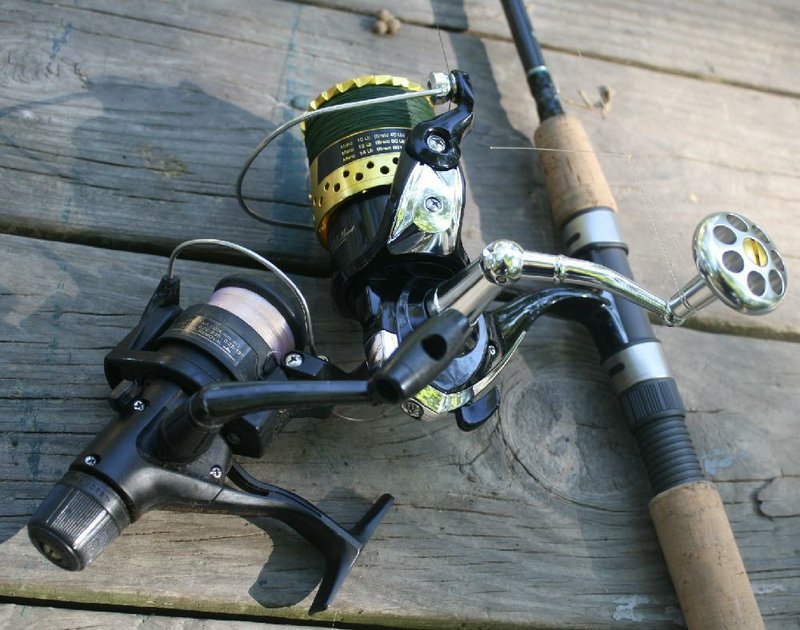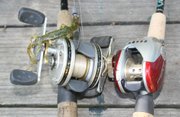If you want to start an argument among fishermen, ask them if spinning tackle is better than baitcasting tackle.
When fishing for largemouth bass, anglers prefer baitcasting tackle. Larry Nixon, a highly accomplished bass pro, said it’s because baitcasting gear is better suited for handling heavy monofilament and fluorocarbon line. He also said he believes baitcasting gear allows you to control big fish better.
Big fish, in this context, means bass ranging from 5-12 pounds.
On the other hand, saltwater anglers distinctly prefer spinning tackle for inshore fishing, and for some offshore applications. Big fish in this context refers to red drum exceeding 35 pounds, speckled sea trout up to 7 pounds, dolphin [mahi-mahi] up to about 60 pounds, tarpon exceeding 100 pounds and sharks exceeding 200pounds.
Kevin Short of Mayflower, a Bassmaster Elite Series Pro, said the type of tackle you use depends almost entirely on the application.
“In the bass fishing world, spinning reels go hand-in hand with finesse fishing,” Short said. “When you see a guy using a spinning rod and reel, he’s throwing 6- to 8- to 10-pound test line, as a rule.”
Such light line doesn’t work well in heavy cover where bass anglers plumb for big largemouths. In that environment, Nixon said 10- to 17-pound test line is normal, and he said that the small spinning reels that freshwater anglers use have spools that are too small for such heavy line. They don’t cast heavy line well, either, he added.
In saltwater, baitcasting reels are used for really big game, like pelagic sharks, tuna, marlin and sailfish, but those are actually trolling winches. For everything else, spinning reels dominate.
However, saltwater spinning reels are much larger than those used for freshwater. Most saltwater anglers spool them with heavy braided line tipped with a heavy monofilament or fluorocarbon leader. They’ll handle any kind of shallow-water fish, including giant freshwater striped bass.
So why don’t more bass anglers use them?
Nixon said one reason is because many spinning reels are prone to snarl. Just as line leaves a spinning reel in coils, it also returns to the spool in coils. This twists the line and ultimately causes it to tangle. If you think a backlash in a baitcasting reel is a headache, a 2-foot snarl in a spinning outfit is a nightmare.
Gary Hubble of Little Rock, a tournament angler and trolling motor technician at N.I.F.E Marine, said bass anglers are simply more comfortable using baitcasting gear because they have used it all their lives.
“I grew up using those old closed-faced Zebcos, the 202 and stuff like that,” Hubble said. “It took me forever to get used to baitcasting, but now that’s all I do. I don’t even have a spinning rod. I tried it once. I reared back and gave it a big, old heave. It went straight up in the air and came back down in the boat.
“You can have it. I don’t want any part of it.”
Hubble and Nixon said baitcasting gear is synonymous with traditional “power fishing” techniques, while spinning gear is better suited for open-water techniques. For that reason, northern and western bass anglers specialize in spinning tactics on waters where most of the fishing is in deep water. That means finesse fishing with shaky head jigs and drop shot rigs on light line.
“When you’re dealing with 6- to 10-pound test line, a spinning reel is the way to go because it handles the line so much better,” Short said. “A lot of guys, whether they’re drop-shotting or using finesse worms, they use 10- to 12-pound braid and a 6- to 8-pound test fluorocarbon leader. They’ve got higher strength on the main line that they can cast freaking forever. The braid has really good sensitivity, but you also get a little shock absorption and transparency with the fluoro leader. It works out real well, especially with a drop-shot.”
Short acknowledged that anglers can catch and land big bass with saltwater spinning tackle as well as with baitcasting, but baitcasting tackle is more precise when precision is crucial.
“I catch 4- and 5-pound smallmouth bass on a 7-foot spinning rod all the time, and a 5-pound smallmouth is going to pull your butt around the boat a lot more than a 10-pound largemouth,” Short said. “But a lot of times, when you’re fishing for largemouth, you’re fishing with big baits, whether it’s a jig, a Carolina rig or a big worm. I think you probably have a little more hook-setting power with a baitcasting rod because of the way you hold it.”
Nobody flips or pitches jigs or worms with a spinning rod, Short explained, because when the bait hits the water it takes a separate, distinct hand motion to close the bail and engage the drive. An experienced spin fisherman can do it quickly, but it still takes time. A bass often takes a bait the instant it hits the water, and that lag can cause you to lose the fish. With a baitcaster, you engage the drive in one deft motion.
Likewise, when you’re throwing a buzzbait, that lag allows the bait to sink. You must reel fast to get it back to the surface, by which time it has left the strike zone.
With a baitcasting reel, a buzzbait is churning the surface back toward the boat the instant it hits the water.
Bass anglers are nothing if not adaptive, however. Twenty years ago, when professional bass fishing was primarily a southern sport, nobody used spinning gear. Western anglers, especially, and some northern anglers stormed to prominence in the early 2000s and brought a whole new suite of techniques into the arena like drop-shots, shaky heads and swimbaits.
That stuff works in the South, too, and successful anglers in these parts often take it for a “spin.”
AND HERE ARE THE DIFFERENCES
BAITCAST TACKLE
A baitcasting reel has a low-profile frame with a spool, or drum, that feeds and retrieves line parallel to the rod. The line goes out straight and comes back straight.
The reel has a push-button or push-lever release and a dual-grip handle that engages the drive with a slight downward push. The adjustment is on the handle stem. Reels are made with right-hand and left-hand retrieve. They are not interchangeable.
A baitcasting rod contains narrow-diameter guides that sit low against the rod.
SPINNING TACKLE
A spinning reel has a long profile and dangles several inches below the rod. Its spool is perpendicular to the rod. To cast, a user opens the bail, pinches the line to the bottom of the rod, then releases the line when the lure reaches its release point. To retrieve line, the user closes the bail to engage the line to the spool.
When cast, line leaves the spool in wide, looping coils. A spinning rod has wide-diameter guides that sit high off the rod to allow the coils relatively free passage.
The drag adjustment mechanism is usually on the front of the spool. Some reels have them on the back of the reel. The handle has a single grip. It can be attached at will to either the left- or right hand side.
Sports, Pages 30 on 07/14/2013

